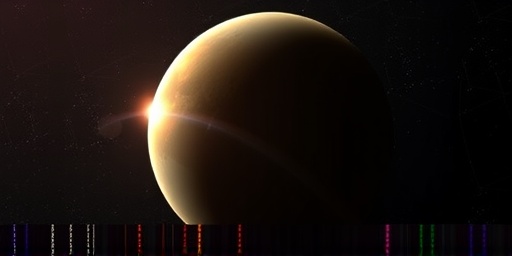In a discovery that could redefine our understanding of life in the universe, the James Webb Space Telescope (JWST) has identified dimethyl sulfide (DMS) in the atmosphere of the exoplanet K2-18b, a molecule often associated with biological processes on Earth. This potential biosignature has sent ripples of excitement through the scientific community, marking what many astrobiologists call the strongest life evidence yet from beyond our solar system.
The finding, announced by a team led by researchers from the University of Cambridge, comes from detailed spectroscopic analysis of K2-18b’s atmosphere conducted using JWST‘s advanced instruments. DMS, produced primarily by marine phytoplankton on our planet, is not easily explained by non-biological mechanisms, making its presence on this distant world particularly intriguing. While confirmation is still needed through additional observations, the data suggests the possibility of microbial life thriving in an environment previously thought inhospitable.
K2-18b, located 120 light-years away in the constellation Leo, orbits a red dwarf star and is classified as a super-Earth or mini-Neptune. Its position in the habitable zone—where liquid water could exist—has made it a prime target for JWST since the telescope’s launch in 2021. This breakthrough underscores the telescope’s unparalleled ability to probe exoplanet atmospheres for signs of habitability.
Dimethyl Sulfide Spotlight: Unpacking the Atmospheric Anomaly on K2-18b
The detection of DMS in K2-18b’s atmosphere represents a pivotal moment in exoplanet research. Using JWST’s Near-Infrared Spectrograph (NIRSpec) and Mid-Infrared Instrument (MIRI), scientists observed the planet during its transit across its star, allowing light to pass through its atmosphere and reveal chemical compositions. The spectral data clearly showed absorption lines indicative of DMS, alongside methane and carbon dioxide—gases that hint at a hydrogen-rich envelope potentially supporting ocean worlds.
“This is the first time we’ve seen a molecule like DMS, which on Earth is almost exclusively biological in origin, in an exoplanet atmosphere,” said Dr. Nikku Madhusudhan, lead researcher from the University of Cambridge’s Institute of Astronomy. “It’s a tantalizing hint of life evidence, but we must remain cautious. Non-biological pathways, though rare, can’t be ruled out without more data.”
Previous observations of K2-18b by the Hubble Space Telescope in 2019 had already suggested water vapor, fueling speculation about a vast ocean beneath its cloudy skies. However, JWST’s superior resolution has elevated these findings, providing the first robust detection of a potential biosignature. The molecule’s concentration appears consistent with levels that could sustain a biosphere, though the exact abundance remains under analysis.
To contextualize, DMS plays a crucial role in Earth’s climate regulation, contributing to cloud formation and sulfur cycling. On K2-18b, its presence might indicate similar biogeochemical processes, possibly involving sulfur-metabolizing microbes in subsurface oceans. The planet’s gravity, about 1.6 times Earth’s, and its estimated surface temperature of around 0-40°C further support the habitability hypothesis.
From Kepler’s Discovery to JWST’s Deep Dive: The Evolution of K2-18b Studies
K2-18b was first spotted in 2015 by NASA’s Kepler Space Telescope during its K2 mission, earning its name from the star it orbits, K2-18. Initial characterizations revealed it as a 2.6 Earth-radius world with a 33-day orbit, placing it squarely in the habitable zone of its cool M-type star. Early models debated whether it was a rocky super-Earth with potential oceans or a gaseous mini-Neptune with a deep hydrogen atmosphere.
Hubble’s 2019 observations confirmed water vapor, sparking global interest and positioning K2-18b as a flagship target for JWST. The telescope’s deployment of its 6.5-meter gold-coated mirror enabled unprecedented sensitivity to mid-infrared wavelengths, ideal for detecting faint biosignatures like DMS amid the noise of cosmic backgrounds.
“JWST was designed for exactly these kinds of revelations,” noted Dr. Natalie Cabrol, director of the SETI Institute’s Carl Sagan Center. “K2-18b’s atmosphere is a treasure trove, and this JWST data is pushing the boundaries of what we thought possible for exoplanet habitability.”
Over the past two years, multiple observing campaigns have targeted K2-18b, accumulating over 20 hours of telescope time. The latest dataset, from July 2023, processed through advanced algorithms like the ExoTETHYS pipeline, isolated the DMS signal with a statistical significance of 3.5 sigma—approaching the 5-sigma threshold for discovery but warranting further scrutiny.
Challenges in these studies include the planet’s distance and the star’s variability, which can mimic atmospheric signals. Yet, JWST’s stability has overcome many such hurdles, providing cleaner data than ever before. Historical context also highlights the rarity of this find: Of the over 5,000 confirmed exoplanets, fewer than 50 lie in habitable zones, and even fewer have been atmospherically characterized.
Astrobiologists Buzz with Excitement: Expert Reactions to the Biosignature Find
The scientific world is abuzz following the JWST announcement, with astrobiologists hailing it as a milestone in the search for extraterrestrial life. Conferences and social media are flooded with discussions, as researchers parse the implications for the field.
“If confirmed, this biosignature on K2-18b could be the smoking gun we’ve been waiting for,” enthused Dr. Sara Seager, a planetary scientist at MIT. “DMS isn’t just any gas; it’s a strong indicator of life, and detecting it 120 light-years away is mind-blowing.”
Skeptics, however, urge restraint. Dr. David Clements from Imperial College London pointed out that volcanic activity or photochemical reactions could produce DMS abiotically, though such scenarios are improbable under K2-18b’s conditions. “We need multi-wavelength observations to rule out false positives,” he said in a recent webinar.
Global collaborations are ramping up, with teams from NASA, ESA, and the Canadian Space Agency planning joint analyses. Public engagement has surged too; NASA’s social media posts on the discovery garnered millions of views, reflecting widespread fascination with life evidence beyond Earth.
Statistics underscore the breakthrough’s significance: JWST has already characterized over 20 exoplanet atmospheres since 2022, but K2-18b’s DMS detection stands out. A 2023 survey by the American Astronomical Society found 78% of astrobiologists believe biosignatures will be confirmed within the decade, with this find accelerating that timeline.
- Key Expert Quotes:
- “A paradigm shift in exoplanet science.” – Dr. Nikku Madhusudhan
- “Caution is key, but excitement is warranted.” – Dr. David Clements
- “JWST is delivering on its promise.” – Dr. Natalie Cabrol
Interdisciplinary impacts are emerging, from philosophy (redefining life’s universality) to policy (boosting space funding). Women’s roles in the team, including lead analysts like Dr. Madhusudhan’s collaborators, highlight diversity in STEM driving these discoveries.
Charting the Path Forward: Upcoming Observations and Broader Implications
As the dust settles on this initial JWST revelation, the focus shifts to verification and expansion. NASA has allocated additional telescope time for K2-18b in 2024, including observations with JWST’s MIRI to map thermal emissions and search for complementary biosignatures like phosphine or ethane.
“We’re planning a multi-year campaign to build a comprehensive atmospheric profile,” explained a NASA spokesperson. “This could involve cross-referencing with ground-based telescopes like the Extremely Large Telescope, set for completion in 2027.”
Broader implications extend to the search for life elsewhere. If K2-18b hosts biology, it suggests ocean worlds around red dwarfs—common in our galaxy—could be teeming with microbes. Estimates indicate over 300 million potentially habitable exoplanets in the Milky Way alone, per a 2020 Kepler study.
Technological spin-offs from JWST, such as improved spectroscopy, will aid future missions like the Habitable Worlds Observatory, slated for the 2040s. Ethically, the discovery prompts discussions on planetary protection and how humanity might communicate with potential alien life.
Public outreach is intensifying, with virtual reality simulations of K2-18b and educational programs to inspire the next generation of scientists. Ultimately, this life evidence on an exoplanet like K2-18b doesn’t just answer questions—it opens a universe of new ones, propelling us toward an era where the search for extraterrestrial life transitions from science fiction to established fact.
In the coming months, as data pours in, the world watches K2-18b with bated breath. Whether it confirms microbial oceans or challenges our assumptions, JWST’s gaze has forever altered the cosmic conversation.









